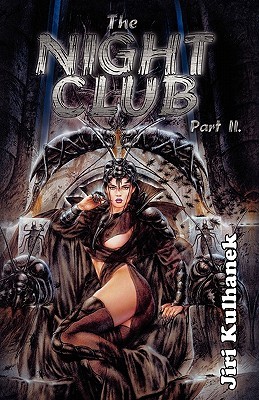The Night Club: Part Two (Jiří Kulhánek, 2009) is the, er, second part in The Night Club duology. It continues the story of Tobias, the Club’s greatest sharpshooter and would-be world famous author.
This is a sequel review, so there’s no-holds-barred spoilers for the first novel. So consider yourself warned!
The novel picks up immediately where the last one left off: Tobias, unwitting vampire (having been saved by his sire Hanako), has escaped Madame Dao’s pirate ship and has so far evaded the reach of her superhuman lackeys Van Vren and Wries. After hearing a familiar voice on the radio, Tobias discovers the the annihilation of the Night Club was incomplete, and he is in fact not the only survivor. With renewed strength and courage, Tobias sets out to find the last remaining Club members and exact revenge upon his captors.
Fair enough, right? I’d be more than a little cross if someone had killed literally my entire family in the most gruesome and painful fashion imaginable, torturing my sister to the brink of madness in the process. I’d be pretty mad indeed.
Content and style-wise, nothing’s really changed from the first book: It’s still all about the murder and gore. Tobias kills some guys, runs away from some guys, gets stronger, kills more guys, does more running… He’s a run-kill-train kind of guy. Thankfully, Tobias is no longer alone in the big, bad world. He re-unites with old allies and makes new, mysterious ones along the way. Of course, the ever-present plot devices Van Vren and Wries are still chasing Tobias, making sure he doesn’t stay in one place for too long and keeping the story going. But who is Mr. Moon, and why does he insist on being called Master?
While reading The Night Club: Part One, I had the strange feeling I was reading the novel equivalent of a shounen anime. For those unaware, a shounen anime is a type of Japanese cartoon that is typically focused around young men and women fighting a series of foes, each more powerful than the last, becoming just strong enough to beat the current enemy but not strong enough to beat the next without serious training or the sudden appearance of a plot device. This is exactly the formula used in The Night Club: Part One for much of that book, and the formula used by the entirety of The Night Club: Part Two. When Tobias isn’t growing stronger through training or science, he’s finding magical artefacts left, right, and centre. This isn’t exactly a bad thing, because the novel needs some sort of justification why this one year-old vampire is taking out nasties who have lived for centuries.
I mean, the novel makes no real attempt to explain why Tobias is capable of the things that no other being has been able to do before. There’s vague allusions to his Night Club training being responsible, along with more concrete suggestions that his righteousness nature (wait, what?) is what makes him so dangerous. It’s also mentioned that his sire Hanako is incredibly powerful, which implies he would be similarly strong.
Anyway, all you need to really know is that Tobias fights a billion guys, gets magic stuff, fights a billion more. There’s a plot about the war between the vampires and the Hidden Race (the pseudo-vampires) somewhere in the middle of all the graphic descriptions of decapitations and clouds of corpse-hungry flies. It’s not a bad plot either, but the novel’s strength seems to be the action scenes. Part Two somehow ends up even more action heavy than Part One!
The last 30% of the novel is wrap-up. Yes, 30% of wrap-up. The last 20% is fairly pointless and only really serves to introduce new characters in case the author feels like a sequel. The story is told and most loose ends are tied up at the 80% mark. The rest seems superfluous.
Of course, if we treat The Night Club as a single volume, it would have only been about 15% of wrap-up and 10% of the author pleading for a sequel.
Speaking of treating it as a single volume, Tobias – who is an author – spends some time bemoaning publishers who force authors to split their work into two volumes. I know authors like placing subtle jabs in their books, but this was literally Kulhánek unashamedly airing his grievances against his publisher through his character. This might have even been an attempt by Kulhánek to justify the abrupt end of Part One! The publisher made him do it! Or maybe he just doesn’t like his publisher. Beats me, you know these artist types.
There was a small disappointment with an interesting plot point in the first novel that was never properly brought up. Back on the pirate ship, Li Pao tortured Tobias with a number of holy symbols, and was amazed that Tobias showed great resistance against them. Tobias knows vampires are weak to these symbols, so why doesn’t he use holy symbols when fighting the vampire hordes that the Hidden Race controls? If I were him, I would have wrapped my body in crosses and holy scripture and just went to town on all the traitors.
Publisher-bashing and missed opportunities aside, I did enjoy The Night Club: Part Two. Even though the ending was fairly weak after delivering a series of stunning punches, the journey was fun. The subterfuge and supernatural elements helped go some way towards counterbalancing the gore, and I ended up rooting for Tobias and the crew after having spent the first novel wondering if this guy was meant to be likeable. If you can stand the idea of reading one story across two books, give The Night Club a go.
– Matthew
P.S. The cover still has no relation to the novel.







